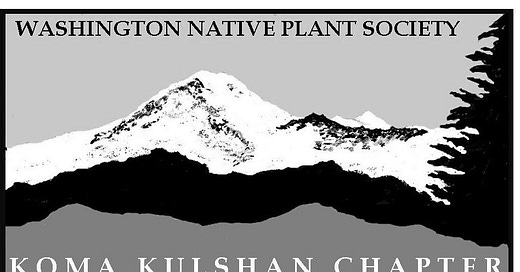Koma Kulshan February Newsletter
the Whatcom County chapter of the Washington Native Plant Society
If you are not already signed up for the Koma Kulshan email group, we strongly encourage you to do so. It’s a great community resource, and a source of reminders for upcoming meetings and field trips. To subscribe, visit the link above and follow the instructions.
SPECIAL UPCOMING EVENT. February 9, 4 pm. Reading at Village Books. John Egbert, Bearings
Naturalist and WNPS member John Egbert will read from his poetry collection Bearings, which is heavy on nature, including plants, birds, and people and nature. “As a naturalist and having been a recent member, I think other members with literary interests might enjoy this reading,” he says.
February Chapter Meeting
To register for Zoom meetings, go to the state events website and scroll down to find the appropriate Koma Kulshan event among other Zoom events associated with WNPS. Meetings begin at 7:00 PM. In person meetings are in the Sustainable Living Center education room at the ReStore (2309 Meridian St.). The entrance is off the back alley and the SLC is upstairs
February 19 (Zoom): Just Add Water: Primary Succession and Dioecy at Mount St. Helens. Register here (Registration link isn’t up yet but keep checking back).
Description: After the eruption of Mt St Helens in 1980, life began to reclaim the devastated landscape almost immediately. Scientists have been monitoring the regreening of the slopes continuously in what is perhaps the longest and most extensive study of primary succession. Among those scientists is Dr. Carri LeRoy, a freshwater biologist who has focused on stream development and colonization by riparian vegetation at Mt St Helens. The prairie lupine was the first flowering plant to appear on the pumice plain and this nitrogen-fixer paved the way for others. Dr. LeRoy will describe her research on the revegetation of Mt St Helens, a story that has many twists and turns related to everything from leaf litter in the water to willow-munching herbivores and even plant sex!
Dr. Carri J. LeRoy is a faculty member at The Evergreen State College in Olympia, WA. She is Director of the Master of Environmental Studies Program. She is also an award-winning mentor of undergraduate research students, and received the Presidential Award for Excellence in Science, Mathematics, and Engineering Mentoring from President Biden in 2021. You can learn more about her work at her research website.
David Lukas Diving into Winter Ecology replay
Did you miss our January Zoom meeting? It was recorded and available for viewing on the WNPS YouTube channel:
February Month Field Trips/Work Parties
February 15, 11:00 AM to 12:30 PM. Introductory Plant Walk. Interurban Trail Rotary Trailhead
Introductory Plant Walk in the 100 Acre Wood, Fairhaven, Bellingham. This event especially welcomes nature novices. Your guide, an experienced amateur naturalist, will help you learn some of the common trees and plants of the forest, and help you learn to see the living story unfolding in the forest, that differs from place to place, and is unfolding over the years, decades, and centuries. Meet at the Interurban Trail Rotary Trailhead, on Old Fairhaven Parkway just west of 20th Street.
Leader: Eric Worden, eric@ericworden.seattle.wa.us, (360) 778-3542.
February 22, 9:00 AM to 12:00 PM. Winter Twigs and Buds on the Clayton Beach Trail. Clayton Beach/Lost Lake Trailhead.
This winter walk led by Abe Lloyd and Allan Richardson will emphasize identification of deciduous trees and shrubs based on their twigs and buds (copies of a key will be provided). There is a diverse assortment of native and some non-native plants along the trail, and other interesting plants among the rocks by the shore. Bring a hand lens (if you have one), snacks, and dress for the weather.
Leader: Contact Abe Lloyd, 360-303-1339 or arcadianabe@yahoo.com to sign up. The number of spaces will be limited.
(Work Party) March 1, 12:00 PM to 3:00 PM. Understory Planting at Reforestation Sit. Whatcom Humane Society Wildlife Rehabilitation Center, 5602 Mission Road (access north from Smith Road).
Join with Whatcom Million Trees Project, Whatcom Humane Society, and the Native Plant Society at the Humane Society Wildlife Rehabilitation Center to plant native understory shrubs among tree seedlings at a reforestation site. You have two opportunities for participating on Saturday March 1st and Saturday March 15th. Planting will be done from 12:00 to 3:00. Wear appropriate clothing and boots (could be muddy). Bring a shovel if you have one handy.
Leader: Sign up here. Contact Allan Richardson (asrichardson5 (at) gmail.com) or Jim Davis (jimdavisscs (at) gmail.com) for more information.
This event especially welcomes nature novices. Your guide, an experienced amateur naturalist, will help you learn some of the common trees and plants of the forest, and help you learn to see the living story unfolding in the forest, that differs from place to place, and is unfolding over the years, decades, and centuries. Meet at the Interurban Trail Rotary Trailhead, on Old Fairhaven Parkway just west of 20th Street.
Leader: Eric Worden, eric@ericworden.seattle.wa.us, (360) 778-3542
Phenology in Focus: iNaturalist
Phenology is the science of cyclic and seasonal natural phenomena in plants and animals and how they are affected by the climate. iNaturalist is a great tool to study phenology, and there’s a new video up on how to do it:
Weekend Field Trip at Mount Saint Helens
Led by Fritz Ulrich.
Date: June 27 - 29, 2025
Location: Iron Creek Campground (Forest Service Road 25, Randle, WA 98377, US)
Hiking Terrain and Difficulty: Friday=moderate, Saturday=mod/hard, Sunday=mod/easy
Pass Requirements: Northwest Forest Pass or Interagency Pass
Group size limit: 10
On June 27, 28, and 29 an extended field trip over a weekend will be offered at the east side of Mount Saint Helens. There are countless opportunities for very exciting hikes in the area and we will choose one for each day of the weekend (see short descriptions below).
We will camp in the Iron Creek Campground for 2 nights from Friday June 27 to Sunday June 29 ($ 27 per site a night). The drive from Bellingham to the campground is roughly 200 miles and takes about 5 hours.
If you are interested in this outing, please sign up at here and register your campsite directly at the campground reservation site to secure a campsite (you might check campsite availability before signing up). Fritz will send all participants a liability release form to be signed. Registration will be open until June 10, 2025 as long as campsites are available and the group size limit is not reached.
You can find some more information about the east side of Mt St Helens here and see a map here.
For questions please contact Fritz at fritz365@gmail.com.
He will lead a hike on each of the weekend days as follows:
Friday, June 27, 2025
Norway Pass via Boundary Trail
Difficulty: Moderate
Leaving Campground at 2:00 pm
Returning to Campground 7:00 pm to 7:30 pm
Info: https://www.wta.org/go-hiking/hikes/norway-pass
A 4.5 miles RT hike with an elevation difference of 900 feet within the blast zone of Mt St Helens 1980 eruption. The vegetation has returned in the meantime and we sure will check out the different plants to be seen. We also expect good views of Mt St Helens and Mt Adams.
Excerpt of a trip report from July 5, 2024:
Trail up to Norway Pass is in good condition. Flowers are out in droves; Sitka Valerian, Scouler's Valerian, Penstemon, Lupine, Paintbrush, Fringecup, Western Serviceberry, Avalanche Lilies, Foamflowers, Bleeding Heart, Rose Spirea, Strawberries, and the list goes on.
Bugs were flying around in swarms the entire day, though when the breeze chose to blow it did help a little.
Saturday, June 28, 2025
Plains of Abraham - Windy Pass Loop
Difficulty: Moderate/Hard
Leaving Campground at 9:00 am
Returning to Campground 6:00 pm
Info: https://www.wta.org/go-hiking/hikes/plains-of-abraham-windy-pass-loop
This hike is on the challenging side and some route-finding might be required for the 9 miles roundtrip and 2,000 feet elevation difference. We will get up close to Mt St Helens and enjoy lots of wildflowers. Of course, we also expect awe-inspiring mountain views.
Excerpt from a July 24 report:
The loop to Windy Pass via Plains of Abraham is one of those hikes that doesn't get much footfall. But it is certainly an underappreciated one. I would give it an 8/10 just for the views: between the open vistas of Spirit Lake, four volcanic peaks and of the undulating moonscape all around. This is in addition to getting up close and personal with Mt St Helens in a way very few other trails do. But this time, with the profusion of wildflowers, I would give it a 10/10. I saw vast fields of dwarf lupines, indian paintbrush, penstemon and much more.
Sunday, June 29, 2025
Mt Rainier East Side Trail to Stafford Falls
Leaving Campground at 9:00 am
Difficulty: Moderate/Easy
Leaving Trailhead for drive back to Bellingham 1:00 pm
Return to Bellingham 6:30 to 7:00 pm
Info: https://www.wta.org/go-hiking/hikes/stafford-falls
This is a hike through one of the most scenic river drainage in the Mt Rainier park, the Chinook Creek and Ohanapecosh rivers. The hike will be about 4 to 5 miles roundtrip with an elevation difference of about 600 feet.
Excerpt from June 23, 24:
This turned out to be a wonderful way to spend a Sunday afternoon. We took the risk of the descent down at the beginning of the hike, knowing that we would be hiking it up at the end. We are SOOO glad we did.
Not too far from the start we came upon the first waterfall, Shriner Falls. This follows you down the forested canyon as you switch back your way down.
This is truly an amazing forest of old growth and new growth. There are some massive trees, cedar, fir and pine. Just when we thought we had seen the biggest, there was another one around the corner.
For questions please contact Fritz at fritz365@gmail.com.
WNPS Opportunities to Contribute
A number of positions have opened in the statewide organization. There are a variety of interesting possibilities to consider: some technical, some writing, or advocacy, or social, or organizing and leadership. These are all volunteer positions. Please read and consider whether you would like to take up a new mantle! Please contact Eric Worden (komakulshan@wnps.org) to learn more.
Facebook Group Moderators - The Facebook Group posts and following has exploded in record numbers. We are looking for a few people who love and use Facebook and can help keep things civil and moving forward on the group.
Publicity - there is a HUGE need to help with getting our message out to the news and media outlets to share our message with the public. We need someone passionate about this that would be willing to build something up and own this!
Writers - there is so much writing that is needed to effectively communicate for the WNPS. We are looking for passionate writers to write stories about PEOPLE in the WNPS. For example, show how an education grant is being used in a community, how a member is contributing to the Plant Lists database, or how students are interacting with the new webinar formats.
Plant Directory Reviewers- The website is in its adolescent phase - and still needs plenty more development. The Native Plant Directory is in need of reviewers to review new plant profiles with searchable fields. Plant profiles would complement other directories out there already. Since technical information is generally available on WTU herbarium and through eFloras and other keys, we're hoping to add gardening and ethnobotanical information to our profiles.
Spanish Translator/Writer - We are looking for someone who can translate key resources from English to Spanish to widen the education reach for WNPS. We would also be interested in new articles written for the Latina community audience.
Ikebana with NW Native Plants
By Joan D. Stamm. For more information, contact her via email at jstamm@seanet.com or visit her website.
Reading Nature’s Best Hope by Douglas Tallamy inspired me to remove my backyard lawn so I could plant a variety of native plants. With more help from Real Gardens Grow Natives by Eileen Stark, I learned what plants needed sun or shade and which bird, insect or butterfly would benefit. By the end of that first year, I had plenty of native flowers for all our native creatures. But when it came to my first passion, ikebana, or Japanese Flower Arranging, there weren’t any books or instruction manuals on how to replace those showy “introduced” flowers with our more subtle natives. For that, I had to look at plant material and ikebana styles in a whole new way. Of course, some native plants like Oregon grape (Mahonia aquifolium), and some of the conifers, like Western red cedar (Thuja plicata) still worked in creating structurally large arrangements. But delicate flowers like Scottish bluebells (Campanula rotundifolia), farewell-to- spring (Clarkia amoena), and nodding onion (Allium cernuum) to name a few, did not compare to oriental lilies, hybrid roses and Itoh peonies. And what to do in winter, when nothing native is blooming.
I discovered that for many native flowers, miniature vases and miniature ikebana seemed to be the answer. In winter, I could use native evergreen shrubs and trees for the main branches and dried pearly everlasting (Anaphalis margaritacea) without resorting to buying flowers shipped in from Ecuador.
Here then are a few of my experiments in ikebana using exclusively NW native plants plus vases from NW potters. As my garden matures, I’m sure there will be many more trials and errors in creating NW native ikebana.
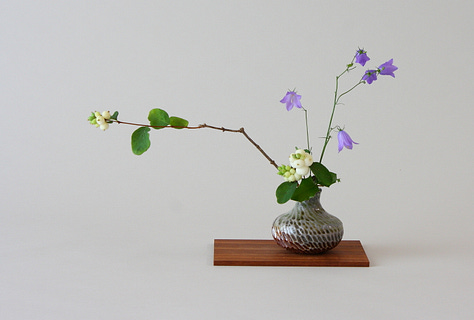
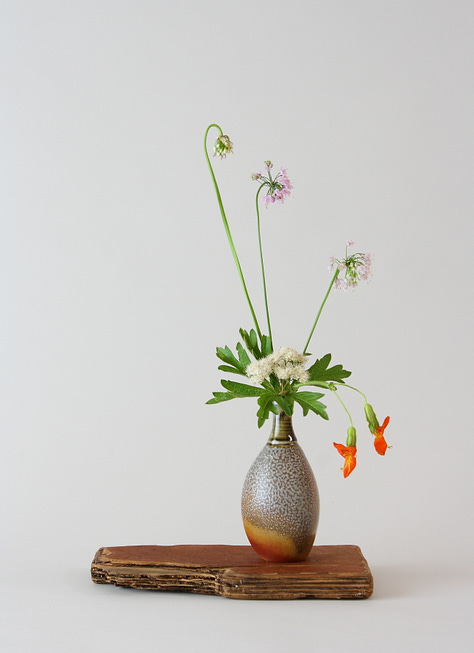
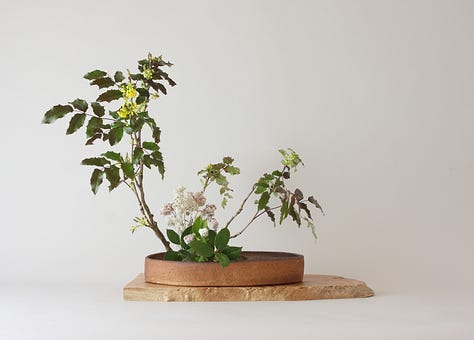
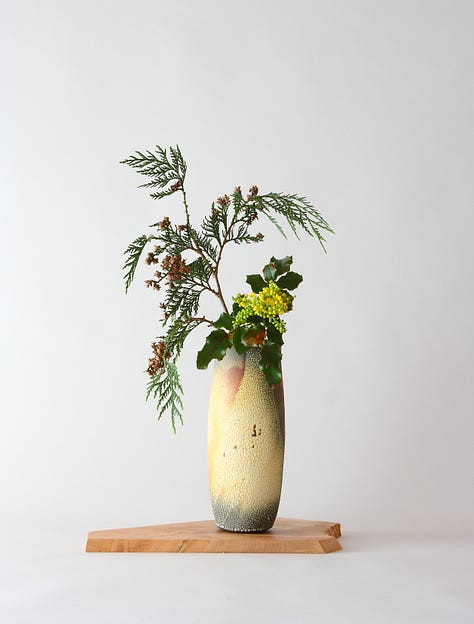

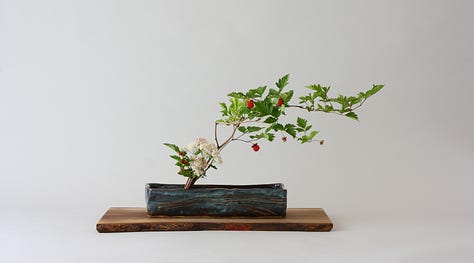
Rose Hips, Invasives, and Resilience
by Eric Worden
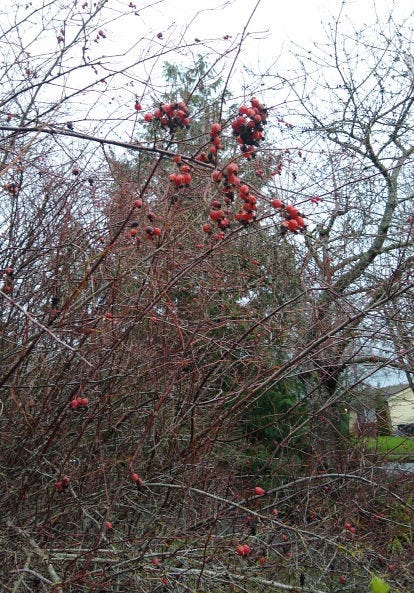

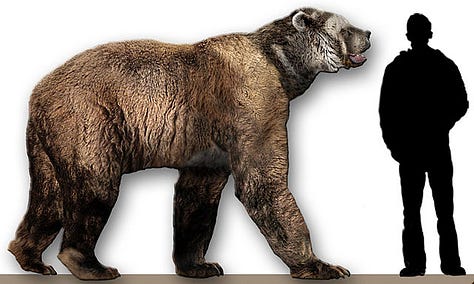
Do any animals eat Nootka rose hips, aside from human granola-eating nature enthusiasts? In my neighborhood in Bellingham, this plant, Rosa nutkana, is commonly found in habitat restoration plantings. It establishes easily and grows vigorously, quickly reaching heights to eight feet and higher. In the fall, the hips emerge in vibrant orange-red at the ends of branches. During November the hips remain fresh, defying the monsoon rain. They persist through December, though begin to weary. January accelerates their attrition to sad, blackening, droopy, squishy remnants of reproductive failure.
Sadly, I realized, nothing eats these rose hips. They are obviously too large and too hard for birds to swallow. High in a thorny thicket, racoons don't seem to reach them. Around here, mule deer also seem to ignore the few hips that they can reach. Even eastern gray squirrels ignore them, favoring the European hawthorn instead. But a quick internet search returned video of grizzly bears eating rose hips with gusto: mystery solved!
Sadly still, a nervous mind never rests. I asked myself, how would this plant evolve to grow fruits at eight feet high? Huge grizzlies don't go around browsing while standing erect. In a mental quantum leap, I thought of other large herbivores that have removed in time rather than in space. I remembered this creature, the giant ground sloth.
In terms of geologic history, this creature — Megatherium jeffersonii — plodded through our forests only yesterday, as recently as 12,000 years ago. Especially with its enormous reaching arms, it could seemingly harvest Nootka rose hips quite effectively. What happened to them and the thirty other species of ground sloths that roamed the Americas? Probably they shared a common fate with the other enormous herbivores that disappeared around the same time, including other possible rose-hip-eaters: short-faced bears, mammoths (both woolly and Columbian), and even camels. Sadly (once again) an invasive species was introduced to North America about 12,000 years ago: Homo sapiens. The megafauna species that survived this invasion seem to have one important characteristic that the extinct species lacked: the instinct and ability to flee.
Perhaps thanks to bears mostly, Rosa nutkana has continued to reproduce and thrive through recent millennia. I suppose in the coming millennia it will evolve either a shorter stature so bears can reach all the fruit, or smaller fruits that birds can swallow.
Though I often feel melancholy about various tragedies of human and natural history, nature also reminds me about its ultimate resilience. After all, only 17,000 years ago there was ice a mile deep covering Whatcom county, and not a single living thing anywhere. 5000 years after that there were forests with giant herbivores. 5000 more years after that there were forests with large primates. 5000 years from now, perhaps a time traveler will find forests inhabited by giant AI squid, with all the primates long since sliced and deep fried. One thing is certain: nature will still be surging with irrepressible vitality. In the meantime, let’s try to protect what we have, ok?
Koma Kulshan Board
Koma Kulshan Board
Chair: Eric Worden, (360) 778-3542, komakulshan@wnps.org
Vice Chair: Fritz Ulrich, fritz365@gmail.com
Secretary: Analiese Burns, analieseb@gmail.com
Newsletter Editor: Jim Kling, jkling@gmail.com
Treasurer: Mark Turner, (360) 671-6851
Programs Chair: Chantal Chaplain, frenchie1982@gmail.com
Field Trip Chair: Angie Nelson, Bellinghamskyline@gmail.com
Grants Committee Chair: Barry Wendling, (360) 393-9181
Publicity Chair: Sky Hawk Bressette, skyhawkbre@outlook.com
Conservation Chair: Jim Davis
Stewardship Chair: Allan Richardson, asrichardson5@gmail.com

